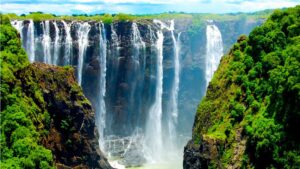By Julio Morejón Tartabull
africa@prensa-latina.cu
Declared a World Heritage Site by the United Nations Educational, Scientific and Cultural Organization in 1989, they are about 1.7 kilometers wide and 108 meters high, and tour operators present them as an exotic cliff. Such a natural miracle is also known as Mosi-oa-Tunya, translated as “the smoke that thunders,” due to the ferocious sound of the water falling and running, while some nine hundred and thirty five million cubic meters per second plummet over the edge.
It’s almost twice as large as the Niagara Falls in Canada and the United States, and competes with those at Iguazú (Argentina and Brazil) and the ones at Moconá (also in those two South American countries).
However, the magnificence of this African wonder went through the consequences of climate change, and in 2019 it was impacted by a serious drought in some areas which threatened to turn it into a “mere trickle,” as a British media outletsaid.
In both the Zambian and Zimbabwean sides there are national parks that increasingly recovered after the above-mentioned problem, the worst in decades, according to many.
Researchers say that it took the waterfalls five million years and many tectonic movements to form as such an environmental jewel in Africa.
(Published in Orbe)
ef/jmt










